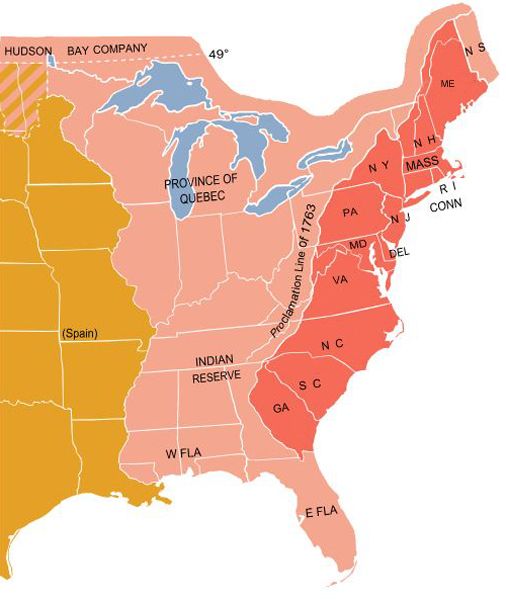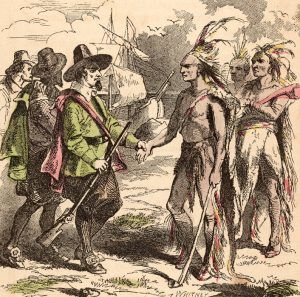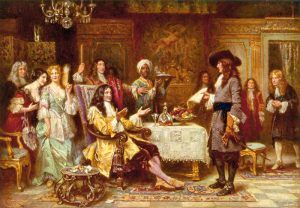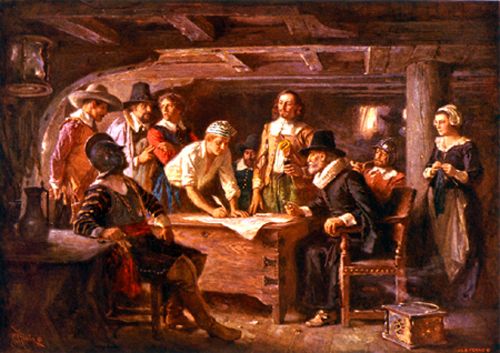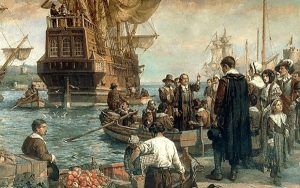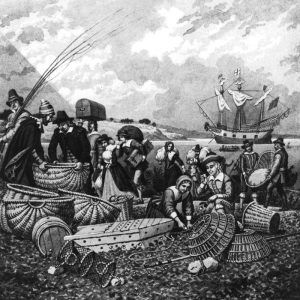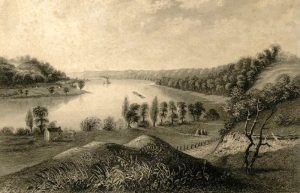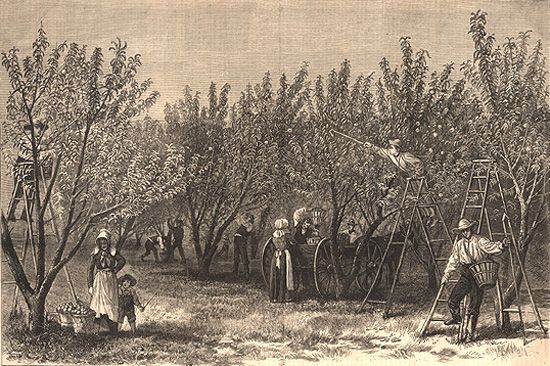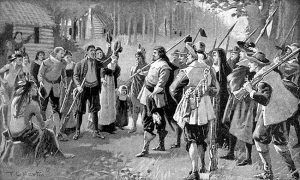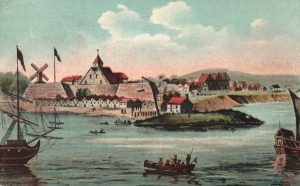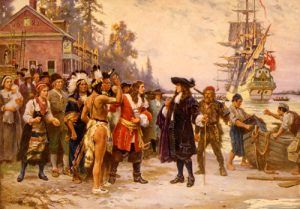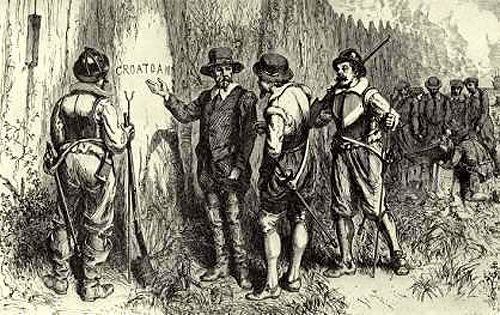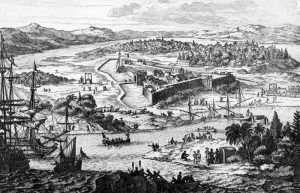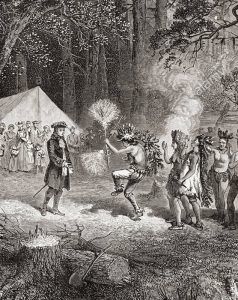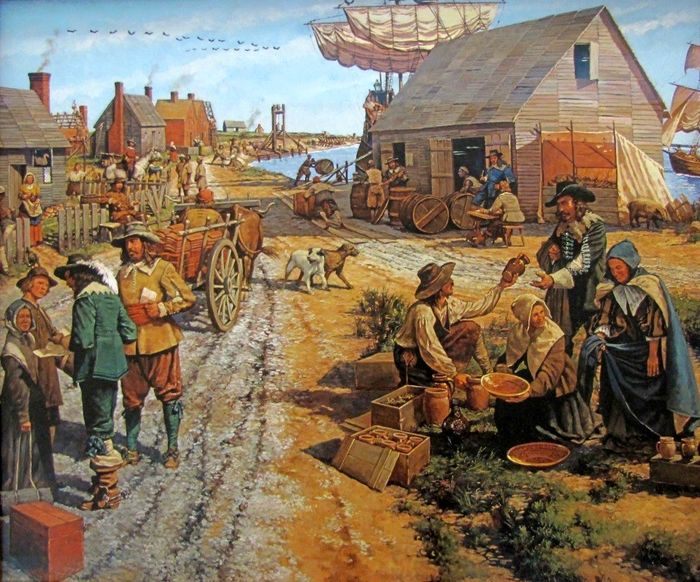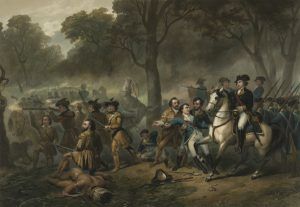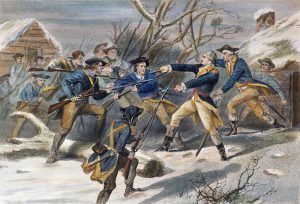The Thirteen American Colonies, founded in the 17th and 18th centuries, were a group of British colonies on the Atlantic coast of North America. These early colonies eventually formed the United States of America.
European nations came to the Americas to increase their wealth and broaden their influence over world affairs. The Spanish were among the first to explore the New World and the first to settle in what is now the United States. Other nations, including France, Sweden, Holland, and England, also explored and claimed land along the Atlantic coastline at the beginning of the 17th century. The struggle to control this land would continue for over a hundred years.
The first colony was founded in Jamestown, Virginia, in 1607. Many people who settled in the New World came to escape religious persecution. The Pilgrims, founders of Plymouth, Massachusetts, arrived in 1620. In both Virginia and Massachusetts, the colonists flourished with some assistance from Native Americans. New World grains such as corn kept the colonists from starving, while, in Virginia, tobacco provided a valuable cash crop.
Other English colonies were also established along the Atlantic coast, from Maine in the north to Georgia in the south. Swedish and Dutch colonies also took shape in and around what is now New York. By 1650, England had established a dominant presence on the Atlantic coast.
The Thirteen Colonies had very similar political, constitutional, and legal systems and were dominated by Protestant English speakers. They were part of Britain’s New World possessions, including colonies in Canada, the Caribbean, and Florida. The colonies had three forms of colonial government: provincial, also called a royal colony, proprietary, and charter.
Provincial colonies were governed by commissions created by the Crown of England. A governor was authorized with executive powers, and the King appointed his council. This type of government also utilized assemblies made up of representatives elected by landowners of the province. The assembly’s role was to make all local laws and ordinances, ensuring that they were consistent with the laws of England. The governor’s council sat as an upper house when the assembly was in session, in addition to advising the governor. The governor had absolute veto power and could delay or dissolve the assembly.
Proprietary colonies were governed much as royal colonies, except that lord proprietors were appointed the governor rather than the king. They were set up after 1660 and typically enjoyed greater civil and religious liberty.
Charter governments were political corporations that, with the blessing of the Crown, were given control of the land and the powers of legislative government. The charters provided a fundamental constitution and divided powers among legislative, executive, and judicial functions under English rules. At any time, the crown might revoke a charter and convert the colony into a crown colony.
These governments were all subordinate to the King of England, with no representation in the Parliament of Great Britain.
France, England, and other countries made several attempts to colonize New England early in the 17th century, and those nations were often in contention for lands in the area. The geography and climate impacted the trade and economic activities of the New England Colonies. Along the coast, the earliest communities were fishing villages. By the end of the 17th century, New England colonists had created an Atlantic trade network. They were involved in fur trading, lumbering, shipbuilding, and other industries, including the manufacture and export of rum. The rocky soil in the New England Colonies was not very fertile, but farming communities were established on the more fertile land along the rivers where corn, pumpkins, rye, squash, and beans were planted. The religion practiced in New England in these early was strictly Puritan, and other religions were not tolerated.
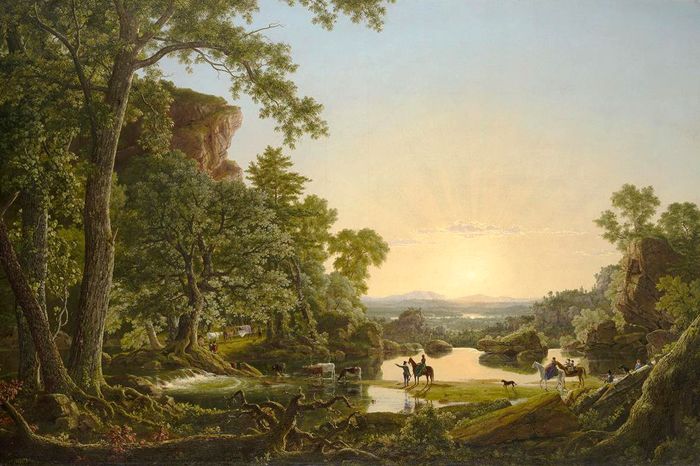
Thomas Hooker and settlers journeying through the wilderness to Connecticut by Frederic E. Church, 1846.
Connecticut Colony – Originally known as the Connecticut River Colony or simply the River Colony, Dutch traders established a permanent settlement near Hartford as early as 1633. Not long afterward, English settlers arrived in the area from Massachusetts. In 1636, after being driven from Massachusetts, Clergyman Thomas Hooker and his followers arrived in the Connecticut River Valley and declared religious freedom. In 1639, three settlements, including Hartford, Saybrook, and New Haven, joined to form a unified government, creating a document called the Fundamental Orders of Connecticut, the first written Constitution in America. King Charles II officially united Connecticut as a single Charter Colony in 1662. In 1788, Connecticut was the fifth state to ratify the Constitution.
Province of Massachusetts Bay – The Pilgrims were the first English colonists to permanently settle in present-day Massachusetts after setting out from Plymouth, England, on the Mayflower in September 1620. Before the 102 passengers decided on their permanent location, they gathered together. The men signed the “Mayflower Compact” agreement on November 21, 1620, that would set the rules to guide them through the early days of establishing a new community. This agreement would serve as the official Constitution of the Plymouth Colony for many years. After exploring the area for nearly a month, by foot and in boats, they decided on a location they named Plymouth on December 21, 1620. More Puritans arrived in Massachusetts over the next decade, settling in the Salem area, and Boston was founded in 1630. Massachusetts began as a Charter Colony, and in 1652, Maine was annexed to Massachusetts. In 1691, the Plymouth Colony was absorbed into the Massachusetts Bay Colony to form the Province of Massachusetts Bay, which became a Royal Colony. In 1788, Massachusetts was the sixth state to ratify the Constitution.
Province of New Hampshire – In 1623, two groups of English settlers, sent by Captain John Mason, arrived in present-day New Hampshire. The colony was named for John Mason’s home in the County of Hampshire, England. These first settlers established a fishing village near the mouth of the Piscataqua River. In 1638, John Wheelwright, banished from Boston, Massachusetts, for defending his sister-in-law Anne Hutchinson, founded a settlement called Exeter in New Hampshire. In 1639, the settlers signed the “Exeter Compact” patterned after the “Mayflower Compact.” Though New Hampshire started as a Proprietary colony, it became a Royal colony in 1679. The New Hampshire Colony sometimes came under Massachusetts jurisdiction throughout the colonial period. In 1776, the province established an independent state and government and joined the other 12 colonies to form the United States. In 1788, New Hampshire was the ninth state to ratify the Constitution, after which it was officially adopted.
Colony of Rhode Island and Providence Plantations – A few Europeans began to settle what would become Rhode Island as early as 1620, but the first permanent settlement wasn’t established until 1636. In 1635, Roger Williams, a Puritan theologian, was driven from Salem, Massachusetts, for espousing religious and political freedom. After spending the winter with Narragansett Indians, he bought land from them and settled in present-day Providence. The new colony became a haven for those seeking religious freedom. In 1638, Anne Hutchinson, a Puritan spiritual adviser who was also banned from Massachusetts, helped found Portsmouth. Rhode Island and Providence Plantations officially became a charter colony in 1663. Among other unique guarantees, the Charter established complete religious freedom in Rhode Island, which was unusual then and later formed the basis for similar provisions in the U.S. Constitution. Although Rhode Island was one of the first colonies to embrace autonomy from the British and espouse Revolutionary ideals, it was the last of the 13 colonies to ratify the Federal Constitution and became a State in 1790.
Middle Colonies:
Much of the area was part of New Netherlands, situated along the Mid-Atlantic Coast until the British exerted control over the region. The British captured much of the area in their war with the Dutch around 1664, and most of the conquered land became the Province of New York. However, the Duke of York and the King of England would later grant others ownership of the land, which would become the Province of New Jersey and the Province of Pennsylvania. The Delaware Colony, founded by William Penn, later separated from Pennsylvania. The four Middle Colonies of Colonial America had good farmland, timber, furs, coal, and iron ore, making the area very attractive to new settlers. The Middle Colonies became major exporters of wheat and other grains. The lumber and shipbuilding industries also enjoyed success because of the abundant forests. Unlike New England, these colonies were not dominated by a specific religion, giving way to freedom for Quakers, Catholics, Lutherans, Jews, and others. This resulted in a diverse population of settlers from England, Scotland, Ireland, the Netherlands, and Germany.
Delaware Colony – The first European settlers of Delaware were the Swedes and the Dutch in the 1630s. In 1655, the Dutch gained control of the land from the Swedish, and in 1664, the English obtained Delaware after defeating the Dutch. Delaware then became a proprietary colony. In 1682, William Penn of Pennsylvania was given the deed to what was then called “the Lower Counties on the Delaware.” Delaware was then governed as part of Pennsylvania until 1701 when the Lower Counties petitioned for and were granted an independent colonial legislature. However, the two colonies shared the same governor until 1776, when Delaware’s assembly voted to break all ties with Great Britain and Pennsylvania. Delaware was the first state to ratify the Constitution and become a State in 1787.
Province of New Jersey – Along with their holdings in New York, New Jersey was originally settled in 1623 by the Dutch as New Netherlands. In 1664, the English gained control of the Dutch holdings between Virginia and New England. The Duke of York made a proprietary grant to Sir George Carteret and Lord Berkeley of the land between the Hudson and the Delaware Rivers. The new grant was named New Jersey for Carteret, governor of the Isle of Jersey, and started as a Proprietary colony. The Dutch Republic reasserted control for a brief period in 1673–1674. After that, it consisted of two political divisions, East Jersey and West Jersey, until they were united as a royal colony in 1702. In 1787, New Jersey was the third state to ratify the Constitution and became an official state in 1783.
Province of New York – The Dutch West India Company explored and began to settle the New York area as early as 1614, but significant settlement did not occur for another ten years. In 1626, Manhattan Island was sold by the local Indians to Dutch settlers and became which was called New Amsterdam. The Dutch holdings in the area were collectively called New Netherlands. In 1664, during the Second Anglo-Dutch War, the Dutch Province of New Netherland was taken over by the English, given to the King’s brother, the Duke of York, and renamed New York. The Dutch struggled with the British for control of New Netherlands until 1674, when the British finally obtained complete control and became a proprietary colony. In 1685 it became a royal colony. In 1788, New York became the eleventh state to ratify the Constitution.
Province of Pennsylvania – Settlement of the area began as early as 1647 by Swedish, Dutch, and English immigrants in the Delaware River region. In March 1681, however, Pennsylvania’s colonial status changed when a royal charter was granted to William Penn, a Society of Friends (Quakers) member. In 1682, the “Frame of Government” for the proprietary colony was enacted. In 1683, the first German settlers arrived in Pennsylvania and formed Germantown near Philadelphia. The main population elements included the Quaker population based in Philadelphia, a Scotch-Irish population on the Western frontier, and numerous German colonies. The proprietary colony’s charter remained in the hands of the Penn family until the American Revolution when the Commonwealth of Pennsylvania was created and became one of the original 13 states. The lower counties on the Delaware River, a separate colony within the province, would break away during the American Revolution as “the Delaware State” and also be one of the original 13 states. In 1787, Pennsylvania became the second state to ratify the Constitution.
Southern Colonies:
The first successful English colony was established at Jamestown in May 1607 near the Chesapeake Bay in present-day Virginia. The region of the Southern Colonies featured fertile soil, hilly coastal plains, forests, long rivers, and swamp areas. The colonies developed prosperous economies based on the cultivation of cash crops, such as tobacco, cotton, indigo, rice, corn, grain, and vegetables. The climate allowed growing crops throughout the year and was ideally suited for plantations. As a result, the Southern Colonies had the largest slave population. Other natural resources, such as fish and timber, spurred the economy. These colonies were not dominated by a specific religion, which gave way to religious freedom.
Province of Carolina – This area was the second attempted English settlement south of Virginia, the first being the failed attempt at Roanoke. A private venture financed by a group of English Lords obtained a Royal Charter to the Carolinas in 1663, hoping that a new proprietary colony in the south would become profitable like Jamestown. King Charles II intended for the newly created province to serve as an English barrier to contest lands claimed by Spanish Florida and prevent their northward expansion. However, Carolina was not settled until 1670 because there was no incentive for emigration to that area. Eventually, the English Lords located fertile and defensible ground at what became Charleston, which a group of 200 colonists founded from English Barbados. More settlers from Georgia and Virginia then moved into the area. The Province of Carolina was controlled from 1663 to 1729 by the lords and their heirs. The colony was divided into the Province of North Carolina and the Province of South Carolina in 1712, and each became a crown colony in 1729. In 1788, South Carolina was the eighth state to ratify the Constitution; in 1789, North Carolina became the 12th state to ratify the new Constitution.
Province of Georgia – The last of the 13 original American colonies established by Great Britain, this proprietary colony began in 1732 when King George II granted a charter to James Edward Oglethorpe, who envisioned a colony that would serve as a haven for English subjects who had been imprisoned for debt. The new Colony was also intended to provide additional protection for its northern colonial partners by providing a buffer against Spanish and French intrusion from the South. In February 1733, the first English settlers arrived at what was to become the city of Savannah. A council of trustees governed the province for the next two decades with annual subsidies from Parliament. However, after many difficulties and the departure of Oglethorpe, the trustees proved unable to manage the proprietary colony, and in January 1755, Georgia became a crown colony. In 1788, Georgia was the fourth state to ratify the Constitution.
Province of Maryland – This proprietary colony was established in 1632 when King Charles I granted a charter to the English Lord Baltimore, who wished to create a haven for English Catholics in the new world at the time of the European wars of religion. Led by Leonard Calvert, Lord Baltimore’s son, the first group set sail for the New World the following year. Although Maryland was an early pioneer of religious toleration in the English colonies, religious strife among Anglicans, Puritans, Catholics, and Quakers was common in the early years. Puritan rebels briefly seized control of the province. Maryland was the seventh state to ratify the Constitution in 1788.
Colony and Dominion of Virginia – The proprietary Colony of Virginia was chartered in 1606 and settled in 1607. It was the first enduring English colony in North America, following failed proprietary attempts at settlement on Newfoundland in 1583 and the subsequent settlement of Roanoke Island, North Carolina, in the 1580s. The founder of the new colony was the Virginia Company, with the first two settlements in Jamestown on the north bank of the James River and Popham Colony on the Kennebec River in modern-day Maine, both in 1607. Jamestown occupied land belonging to the Powhatan Confederacy and was on the brink of failure before the arrival of a new group of settlers and supplies by ship in 1610. Tobacco became Virginia’s first profitable export. In 1619, a group of 20 African slaves arrived on a Dutch ship in Jamestown. Virginia became a crown colony in 1624. In 1788, Virginia was the 10th state to ratify the Constitution and recommended the Bill of Rights be added.
Between 1625 and 1775, the colonial population grew from roughly 2,000 to over 2.5 million, displacing American Indians. This population included people subject to a system of slavery, which was legal in all of the colonies before the American Revolution. In the 18th century, the British government operated its colonies under a policy of mercantilism, in which the central government administered its possessions for the economic benefit of the mother country.
The Thirteen Colonies had a high degree of self-governance, had active local elections, and resisted London’s demands for more control. As more and more people arrived in the New World, numerous disputes and wars arose over territory. Soon, the two countries with the most significant presence were England and France. The two nations fought for control of North America in the French and Indian War (1754-1763). England won the war, got control of Canada, and kept control of all the English colonies.
However, the war increased tensions between Britain and the Thirteen Colonies. In the 1750s, the colonies began collaborating instead of dealing directly with Britain. After the war, Britain had a staggering war debt, which influenced many of its policies over the next decade. Attempts to raise money by reforming colonial administration, enforcing tax laws, and placing troops in America led directly to conflict with colonists. By the mid-1770s, American and British administration relations had become strained and acrimonious. In the meantime, inter-colonial activities cultivated a sense of shared American identity. They led to calls for protecting the colonists’ “Rights as Englishmen,” especially the principle of “no taxation without representation.”
Grievances with the British government led to the American Revolution, in which the colonies collaborated in forming the Continental Congress. The colonists fought the American Revolutionary War (1775–83) with the aid of France and, to a significantly smaller degree, the Dutch Republic and Spain.
Compiled by Kathy Alexander/Legends of America, updated February 2024
Also See:
Causes of the American Revolution
English Colonials to American Patriots
Sources:

